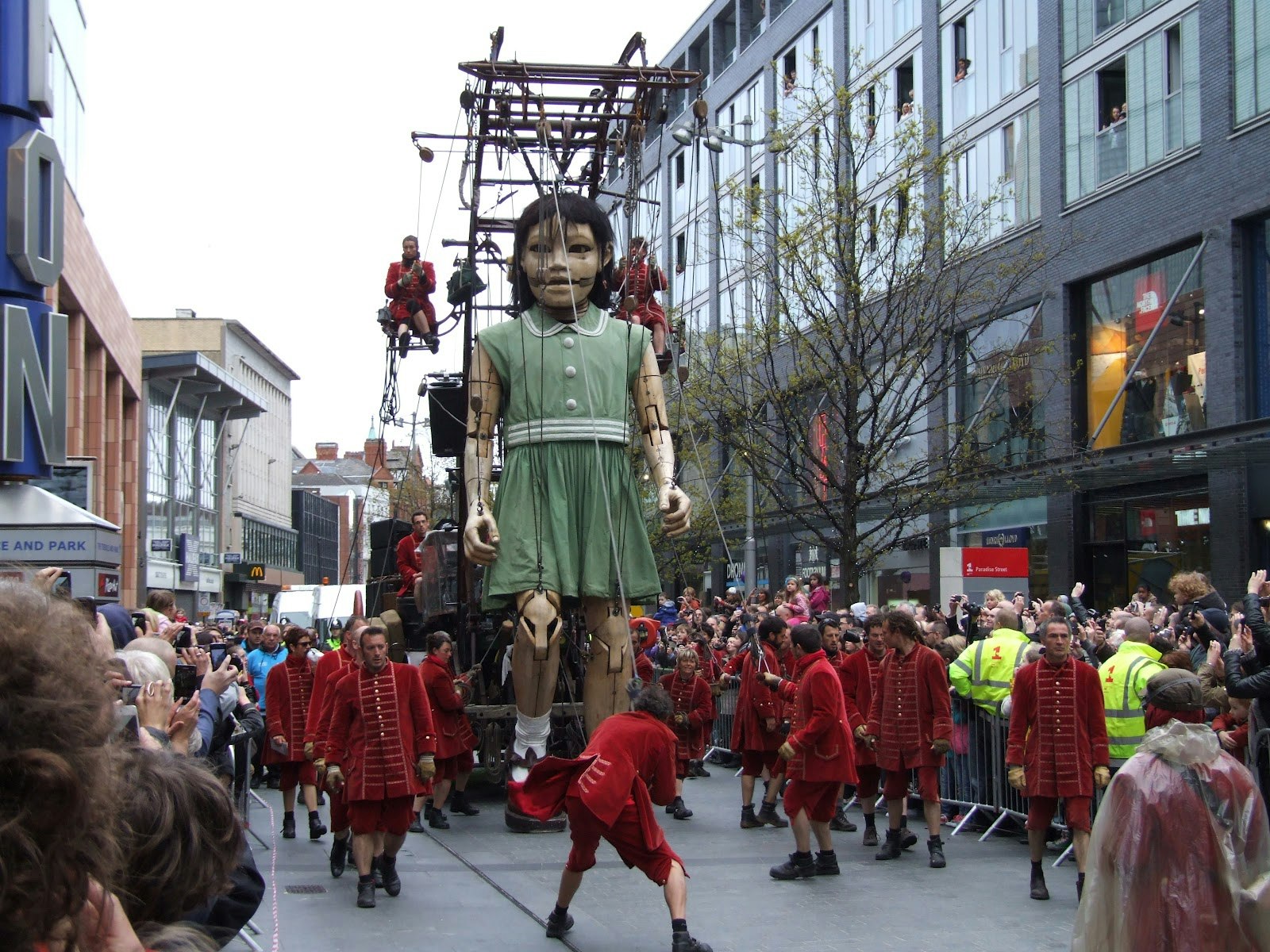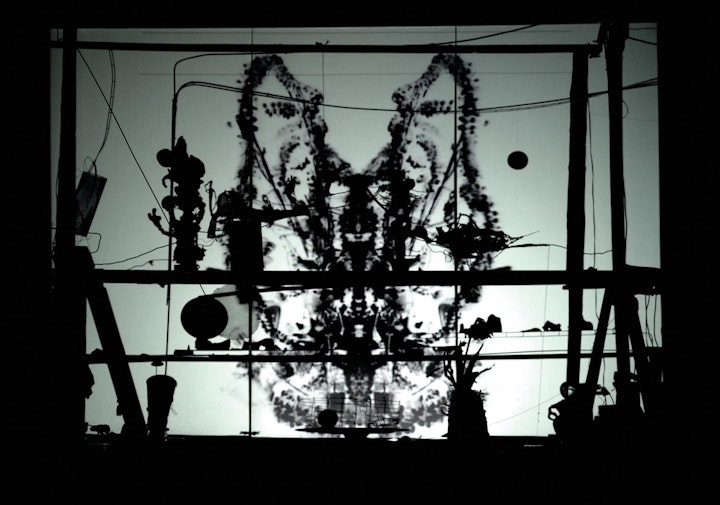On Wednesday 12th November, I attended a QUORUM event at The Queen Mary University of London. Joslin McKinney (theatre designer), from the University of Leeds, presented a paper entitled 'Contraptions and assemblages: scenography and spectatorship'.
Abstract: A contraption is an intricate, elaborate mechanism. In the context of theatre, scenographic ‘contraptions’ frame and shape the stage space and intervene in the physical performance. Sometimes these contraptions seem to overstep their mark and are seen to be cumbersome or excessive. At other times their action is more effectively integrated to the performance as a whole and they can be considered more as a contribution to a conglomeration of parts or as actants within an assemblage. Often the behaviour of stage objects has been discussed either in relation to, or as an extension of, the actor (e.g. Sofer, McAuley). But I want to look at these contraptions as active elements in their own right and focus on the ways in which they work on the spectator. The examples I will refer to will include work such as Royal de Luxe’s giant puppets, Kris Verdonck’s installations such as Actor#1, Heiner Goebbels’ Stifter’s Dinger and Verdenteatret’s The Telling Orchestra, but I will also make reference to examples from the past such as Lyubov Popova’s set for the Magnanimous Cuckold, and the ‘poor’ objects and ‘bio-objects’ of Tadeusz Kantor. I will be focusing on the materiality and agency of the things themselves and the ways in which contraptions make an active and agentive contribution to the aesthetic event. To do this I will call on the ideas of affordance (J J Gibson), draw on phenomenological and new materialist perspectives (Tim Ingold and Jane Bennett).
Presenter: Dr Joslin McKinney is an Associate Professor in Scenography at the University of Leeds, UK and Programme Manager for the MA in Performance Design at Leeds. Joslin has a first degree in Theatre Design and 10 years professional experience as a set and costume designer. In 2008 she was awarded a PhD for her practice-led study into the communication of scenography. She is lead author of the Cambridge Introduction to Scenography (CUP, 2009) and has published articles and chapters on the spectacle of scenography, empathy and exchange in scenography and scenographic research methods. Joslin was co-director of the Performance Studies international (PSi) conference in Leeds, UK, 2012 and a member of the PSi board from 2011 -2013. In April 2014 she directed Performance, Place, Possibility, a one day symposium aimed at exploring ways in which the relationships between performance and place impact on audiences, communities, citizens and the city which was organised in tandem with Ludus Festival Leeds: http://ludusfestival.org
Event: QUORUM is a free event, organised by PHD students from the Drama department of Queen Mary University of London. approximately 6 events are held every semester and the speakers chosen by the students according to their areas of study. The event includes presentations, Q & A, refreshments and informal discussion.
Notes from the event:
Joslin is theatre designer but more interested in What scenography does to an audiences? She has just completed her PHD study which included practise led methods to pursue this idea.
How does scenography communicate: multi-sensory thing, embodies active and engage mode of spectatorship. More than just simply visual. How all the senses work together. The material nature of the work influenced by phenomenal.
Contraptions and assemblages includes settings,collections of objects, machines and devises. There is a concern that these objects might usurp actors and have a life of there own. fear of objects getting above themselves, 'scenophobia' - resistant fear for visual scenography.
assemblages a different notion of a machine, a gathering together of objects, found things, disparate entities. components that each have their own characteristic but connect up.
Context of research, want to explore the areas are inactive cognitive - feed Bruce Meconneky.
NIkki imagining autism project - cognitive science, scenographic environment for children with autism and how that works. Cognition and objects. Man and object the continuum between actor and object. Overlap phonology and cognition.
Minty Donald: site specific work written about, perspective of new materialism. more than human.
The Magnanimous Cuckold Meyerhold/Popova - machine at the centre.
machine that shows the athleticism of actors - play down illusionistic. social and political context. machine comments ont he action. the wheels turn at different speeds. Saying something. This afford meaning which unfold in the action. Extent to which that might be the case.
Tarelkin's Death Meyerhold/stepanova : each has a gimmick such a chair which fold down these didn't work, capricious objects. acting instrument shattered the nerves of the actors.
Tadeusz Kantor's bio-objects (wood)
Confrontation between actors and objects. Madman and the nun. the idea a machine of annihilation. folding chairs and one lifts up and the others follow. Actors would have to compete with this. unpredictability. Actors had to behave spontaneously. situations so they would act int he moment. Kantor: An actor imitating an action better to do the action. Wardrobe - illusion transport of holocast - contraptions seem like instruments of torture.
Bio objects symbiotic with actor. The man with a suitcase - names of bio objects man with a sack and its unknown contents, the helpless man with a table. - link to Jews. materiality. without these objects the actors would be empty. physical possibilities and material qualities - modest or despised, new power through there presence on stage and also with actor in performance.
metaphoric of holocast would now be clearly recognised. not talked about at the time.
Carl Knappett The affordances of Things: Extract
seamless interaction, human in the material world.
mind and world
60's and 70's James Jerome Gibson - perception
kinaesthetic - movement. affordance.
not confined to the visual all connected through kinaesthetic, noticing movement.
connection of the senses. this flux of energy between our bodies and environment.
linking up of senses and gravity. perception through movement.
'invariant' affordances Gibson Ecological approach to perception 138 -9
An affordance is not bestowed upon an object by the need of an observer and his act of perceiving it'
what an observer may or may not perceive.
relational dimension
Harry Heft affordances and the body 12
environment and the body, body presents as we move around the world, inhabits the work in an intentional way.
Maurice Merieau - Ponty
an intertwining to the viewer and the world. Actors and objects relationship. spectatorship. more meaningful engagement with the environment.
thing power: jane Bennett in Vibrant Matter. 'things have a power'
Strifters Dinge Heiner Geobbels - performance without performers - pianos. 'all maintain there own forces... a light can be so strong you only notice the light and forget the text...
Sea Odyssey Royal de Luxe, popularist, big, bold brash

bodily engagement with this performance in relation to affordances. The objects themselves, the way they are held (mechanisms) enslaved, relationship with operators, tending to them. giants have there own action and life. the way they have been crafted - choice of materials e,g, hair offers independent movement. scale is interesting. makes you look around at the city in different ways. the audience they attract, people standing back, moving like a kind of tide through the city. the layout of the street and the buildings these giants pass are important. all part of this event, see city in new light. relational pull, intentional arc how it worked on audience.
Kris Verdonk
giant tank of fog: more agitated, threatens to come out over the top then subsides. strong movement quality, hard not to feel in our own body. lighting from within the tank.
Small robot controlled by compressed air. performance determined through scenographic means. addresses creation and the relationship between materiality, technology and human beings. audience response - see each other in the light, antromorph this robot. stupid little thing, relationship build, hard to detach willing it to stand up right.
not just material anchors - much more them playing an active role as part of the environment. material qualities and behaviour stay with you.
'Active role of the environment'.
physical affordances which lead into further ideas into what these might mean.
The extended mind: Andy clark and David chambers. - fundamental connection to the environment, using those objects.
objects might be concepts you can use. bleed several together to make new insights. material anchors - ofload complex cognitive processes. navigation systems.
Tim Ingoid Making
idea unfolding field of forces and energies. weather. conversation - two and fro of the environment.
ecology of theatre Teema - Paavolainen
Objects - carry with them purposeful what their maker intended for them. what was the designer intending? Materials - distinctive capacities and points.
Things
not inert things - lively gathering of materials, gathering of lively matter.
Vibrant matter and assemblages: adhok grouping. power of objects -
Jane Bennet
The telling Orchestra Verdensteatret
fragile - liable to break down, installation, motors whirring, technician supporting it.
radio signals, recoded sound. communications start up but don't go anywhere. rhythms of the movements. lighting sound and objects link together. recognition. receptacle process at the time. only after think on it intellectually.

